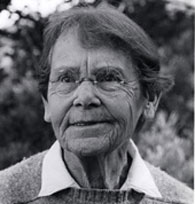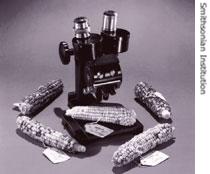VOA慢速英语 2008 0504
时间:2019-01-11 作者:英语课 分类:VOA慢速英语2008年(五)月
PEOPLE IN AMERICA - Barbara McClintock, 1902-1992: She Made Important Discoveries About Genes 1 and Chromosomes 3
She was the first American woman to win an unshared Nobel Prize. Transcript 4 of radio broadcast:
03 May 2008
VOICE ONE:
I’m Doug Johnson.
VOICE TWO:
And I’m Barbara Klein with PEOPLE IN AMERICA in VOA Special English. Today, we tell about Barbara McClintock. She was one of the most important scientists of the twentieth century. She made important discoveries about genes and chromosomes.
(MUSIC)
VOICE ONE:

Barbara McClintock
Barbara McClintock was born in nineteen-oh-two in Hartford, Connecticut. Barbara was the third of four children. Her family moved to the Brooklyn area of New York City in nineteen-oh-eight. Barbara was an active child with interests in sports and music. She also developed an interest in science.
She studied science at Cornell University in Ithaca, New York. Barbara was among a small number of undergraduate students to receive training in genetics in nineteen twenty-one. Years later, she noted 6 that few college students wanted to study genetics.
VOICE TWO:
In the early nineteen twenties, genetics had not received widespread acceptance as a subject. Only twenty years had passed since scientists rediscovered the theories of heredity. Gregor Mendel proposed these ideas after completing a series of experiments with plants. His experiments helped scientists better understand how genes operate. They showed how genetic 5 qualities are passed to living things from their ancestors.
VOICE ONE:
Barbara McClintock decided 7 to study botany, the scientific study of plants, at Cornell University. She completed her undergraduate studies in nineteen twenty-three. McClintock decided to continue her education at Cornell. She completed a master’s degree in nineteen twenty-five. Two years later, she finished all her requirements for a doctorate 8 degree.
In the late nineteen twenties, McClintock joined several other students in a group that studied genetics. The students included a future winner of the Nobel Prize, George Beadle. Another was Marcus Rhoades. Years later, he would become a leading expert in genetics.
McClintock said both men recognized the importance of exploring the connection between genes and chromosomes.
McClintock stayed at Cornell after she completed her education. She taught students botany. She also supervised genetic studies of the corn plant, or maize 9. She studied chromosomes, which are lines of genes. She made several discoveries about genes and chromosomes.
VOICE TWO:
The nineteen thirties were not a good time to be a young scientist in the United States. The country was in the middle of the great economic Depression. Millions of Americans were unemployed 10. Male scientists were offered jobs. But female geneticists were not much in demand.
McClintock received two offers to travel and carry out research projects. The first came from America’s National Research Council. She worked at several places, including Cornell and the University of Missouri in Columbia. Later, a group called the Guggenheim Foundation provided financial aid for her to study in Germany. McClintock went to Berlin, but returned to Cornell the following year. Her skills and work were widely praised. But she still was unable to find a permanent job.
(MUSIC)
VOICE ONE:
For years, scientists had been using x-rays to study genetic material in plants and other organisms. They found that x-rays caused genes to change. Sometimes, the x-rays physically 11 broke the chromosome 2. Genetic researchers looked for changes in the organism. Then they used this information to produce a map linking the changes to a single area of the chromosome.
McClintock became interested in the way genes reacted to unusual events. She formed a successful working relationship with Lewis Stadler of the University of Missouri. He had demonstrated the effects of x-rays on corn.
Stadler sent maize treated with radiation to McClintock. She identified unusual areas she called ring chromosomes. She believed they were chromosomes broken by radiation. The broken ends sometimes joined together and formed a circle, or ring. This led her to believe that a structure at the end of the chromosome prevents chromosomes from changing. She called this structure the telomere.
VOICE TWO:
Stadler got the University of Missouri to offer a permanent position to McClintock in nineteen thirty-six. She became an assistant professor. During her time at the university, she worked with plants treated with x-rays. She also discovered plants with chromosomes that broke without help of radiation. She described this activity as the breakage-fusion-bridge cycle.
University officials and professors recognized the importance of McClintock’s research. Yet she believed that she was not able to make progress in her position. So she decided to leave the University of Missouri.
(MUSIC)
VOICE ONE:
An old friend from Cornell, Marcus Rhoades, invited McClintock to spend the summer of nineteen forty-one working at the Cold Spring Harbor Laboratory. It is a research center on Long Island, near New York City.
McClintock started in a temporary job with the genetics department. A short time later, she accepted a permanent position with the laboratory. This gave her the freedom to continue her research without having to teach or repeatedly ask for financial aid.
At Cold Spring Harbor Laboratory, McClintock continued her work with the breakage-fusion-bridge cycle. She found that some corn plant genes acted in an unusual way. They appeared to move from cell to cell during development of corn particles, or kernels 12. She discovered that the genes moved on and between chromosomes.
VOICE TWO:
McClintock confirmed her discovery and extended her observations for six years. The changes could not be explained by any known theory. So, she developed her own theory. She believed the moveable genes were not genes at all, but genetic controllers or controlling elements. She said they influenced the actions of other genes.
During this period, McClintock was elected to the National Academy of Sciences. She was the third woman ever so honored. She also was named president of the Genetics Society of America.
VOICE ONE:
In nineteen fifty-one, McClintock was asked to present her findings at a conference held at Cold Spring Harbor Laboratory. Her report described the movement of genes from one part of a chromosome to another. She used the presentation to discuss her ideas of controlling elements in genes.
The other scientists reacted to her ideas with a mixture of criticism and silence. Most scientists believed that genes did not move. Few people seemed to accept her findings. Yet others argued that her experiments were complex and difficult to explain, even to other scientists. They said she would not have been invited to speak unless conference organizers understood some of the importance of her work.
(MUSIC)
VOICE TWO:

Barbara McClintock's microscope and five ears of corn at the National Museum of American History
For years, many scientists dismissed McClintock’s findings. During this period, she continued doing her own work and reaching her own findings. Beginning in the late nineteen fifties, she went to Central and South America to study different kinds of maize plants. She examined the development of agricultural maize by native peoples. She also assisted younger scientists and students in genetics.
Her work at the Cold Spring Harbor Laboratory was recognized in nineteen seventy. She was given the American government’s highest science award – the National Medal of Science.
VOICE ONE:
By the nineteen seventies, newly developed methods of molecular 13 biology confirmed what McClintock had learned through observation. Her discoveries have had an effect on everything from genetic engineering to cancer research.
McClintock won the Nobel Prize for Physiology 14 or Medicine in nineteen eighty-three for her discovery of the ability of genes to change positions on chromosomes. She was the first American woman to win an unshared Nobel Prize.
Barbara McClintock remained at Cold Spring Harbor for the rest of her life. She died in nineteen ninety-two. She was ninety years old.
(MUSIC)
VOICE TWO:
This program was written by George Grow. Lawan Davis was our producer. I’m Barbara Klein.
VOICE ONE:
And I’m Doug Johnson. Join us again next week for PEOPLE IN AMERICA in VOA Special English.
- You have good genes from your parents, so you should live a long time. 你从父母那儿获得优良的基因,所以能够活得很长。 来自《简明英汉词典》
- Differences will help to reveal the functions of the genes. 它们间的差异将会帮助我们揭开基因多种功能。 来自英汉非文学 - 生命科学 - 生物技术的世纪
- Chromosome material with exhibits of such behaviour is called heterochromatin.表现这种现象的染色体物质叫做异染色质。
- A segment of the chromosome may become lost,resulting in a deletion.染色体的一个片段可能会丢失,结果产生染色体的缺失。
- Chromosomes also determine the sex of animals. 染色体也决定动物的性别。 来自《简明英汉词典》
- Each of four chromosomes divide longitudinally. 四种染色体的每一种都沿着纵向分裂。 来自《现代汉英综合大词典》
- A transcript of the tapes was presented as evidence in court.一份录音带的文字本作为证据被呈交法庭。
- They wouldn't let me have a transcript of the interview.他们拒绝给我一份采访的文字整理稿。
- It's very difficult to treat genetic diseases.遗传性疾病治疗起来很困难。
- Each daughter cell can receive a full complement of the genetic information.每个子细胞可以收到遗传信息的一个完全补偿物。
- The local hotel is noted for its good table.当地的那家酒店以餐食精美而著称。
- Jim is noted for arriving late for work.吉姆上班迟到出了名。
- This gave them a decided advantage over their opponents.这使他们比对手具有明显的优势。
- There is a decided difference between British and Chinese way of greeting.英国人和中国人打招呼的方式有很明显的区别。
- He hasn't enough credits to get his doctorate.他的学分不够取得博士学位。
- Where did she do her doctorate?她在哪里攻读博士?
- There's a field planted with maize behind the house.房子后面有一块玉米地。
- We can grow sorghum or maize on this plot.这块地可以种高粱或玉米。
- There are now over four million unemployed workers in this country.这个国家现有四百万失业人员。
- The unemployed hunger for jobs.失业者渴望得到工作。
- He was out of sorts physically,as well as disordered mentally.他浑身不舒服,心绪也很乱。
- Every time I think about it I feel physically sick.一想起那件事我就感到极恶心。
- These stones contain kernels. 这些核中有仁。
- Resolving kernels and standard errors can also be computed for each block. 还可以计算每个块体的分辨核和标准误差。
- The research will provide direct insight into molecular mechanisms.这项研究将使人能够直接地了解分子的机理。
- For the pressure to become zero, molecular bombardment must cease.当压强趋近于零时,分子的碰撞就停止了。
- He bought a book about physiology.他买了一本生理学方面的书。
- He was awarded the Nobel Prize for achievements in physiology.他因生理学方面的建树而被授予诺贝尔奖。